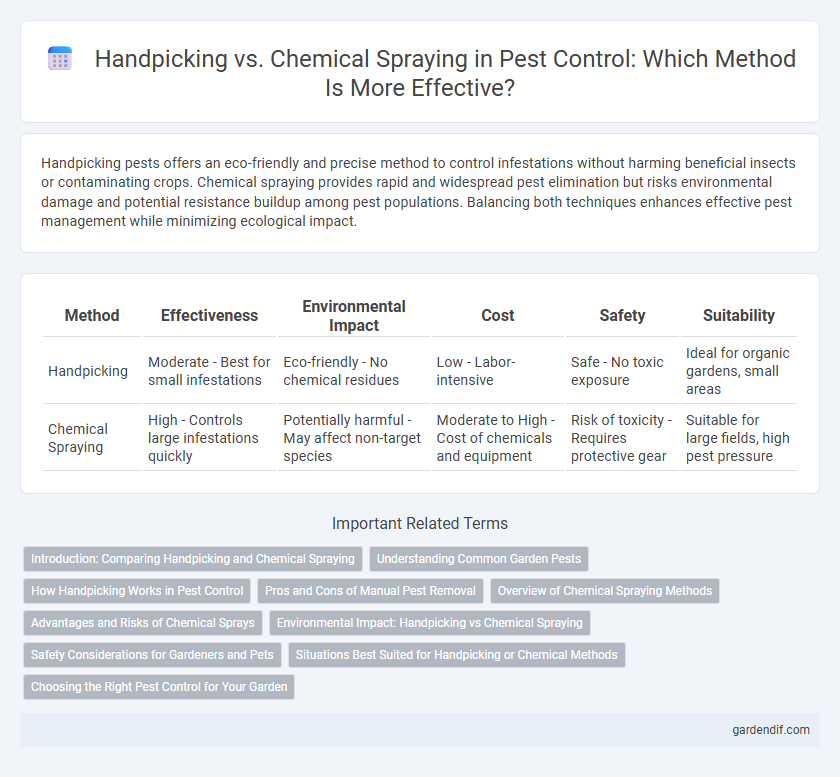
Handpicking vs Chemical Spraying Illustration
Handpicking pests offers an eco-friendly and precise method to control infestations without harming beneficial insects or contaminating crops. Chemical spraying provides rapid and widespread pest elimination but risks environmental damage and potential resistance buildup among pest populations. Balancing both techniques enhances effective pest management while minimizing ecological impact.
Table of Comparison
| Method | Effectiveness | Environmental Impact | Cost | Safety | Suitability |
|---|---|---|---|---|---|
| Handpicking | Moderate - Best for small infestations | Eco-friendly - No chemical residues | Low - Labor-intensive | Safe - No toxic exposure | Ideal for organic gardens, small areas |
| Chemical Spraying | High - Controls large infestations quickly | Potentially harmful - May affect non-target species | Moderate to High - Cost of chemicals and equipment | Risk of toxicity - Requires protective gear | Suitable for large fields, high pest pressure |
Introduction: Comparing Handpicking and Chemical Spraying
Handpicking pests involves manually removing insects from plants, providing an organic and environmentally friendly pest control method ideal for small-scale gardens. Chemical spraying utilizes insecticides to eliminate large populations rapidly, offering efficient pest management but risking environmental harm and pesticide resistance. Evaluating these approaches requires balancing effectiveness, ecological impact, and crop safety to determine the best pest control strategy.
Understanding Common Garden Pests
Handpicking garden pests such as aphids, caterpillars, and beetles offers a targeted, eco-friendly approach that minimizes harm to beneficial insects and the environment. Chemical spraying provides rapid control of widespread infestations but can disrupt garden ecosystems and promote pesticide resistance in pests like spider mites and whiteflies. Understanding the behavior and life cycle of common pests ensures effective pest management while balancing ecological health and crop protection.
How Handpicking Works in Pest Control
Handpicking in pest control involves manually removing pests such as beetles, caterpillars, and aphids from plants, significantly reducing pest populations without chemical intervention. This method is highly effective in small gardens or localized infestations, targeting pests directly while preserving beneficial insects and minimizing environmental impact. Frequent inspections and prompt removal help prevent pest reproduction, making handpicking a sustainable and eco-friendly pest management strategy.
Pros and Cons of Manual Pest Removal
Manual pest removal through handpicking offers precise targeting of pests, minimizing harm to beneficial insects and reducing chemical residues on plants, which supports organic gardening practices. However, it is highly labor-intensive and time-consuming, making it impractical for large infestations or expansive gardens. Unlike chemical spraying, handpicking provides an environmentally friendly method but lacks the broad-spectrum efficiency necessary for rapid pest population control.
Overview of Chemical Spraying Methods
Chemical spraying methods involve applying synthetic pesticides or herbicides directly to crops or affected areas to control pest populations efficiently. These methods utilize various techniques such as foliar spraying, soil treatment, and systemic application to target specific pests while minimizing plant damage. Proper calibration, timing, and safety precautions are essential to maximize effectiveness and reduce environmental impact.
Advantages and Risks of Chemical Sprays
Chemical spraying offers rapid and broad-spectrum pest control, effectively targeting large infestations with minimal labor compared to handpicking. However, chemical sprays pose risks including potential harm to beneficial insects, environmental contamination, and the development of pest resistance over time. Proper application and choice of selective pesticides can mitigate some risks but require careful management to balance efficacy and safety.
Environmental Impact: Handpicking vs Chemical Spraying
Handpicking pests minimizes environmental damage by avoiding toxic chemicals that can harm beneficial insects, soil health, and water quality. Chemical spraying often leads to residue contamination, pest resistance, and disruption of local ecosystems. Choosing handpicking supports sustainable pest management and preserves biodiversity.
Safety Considerations for Gardeners and Pets
Handpicking pests in gardens ensures maximum safety for gardeners and pets by eliminating exposure to harmful chemicals and reducing risk of allergic reactions or poisoning. Chemical spraying, while effective for large infestations, poses risks such as skin irritation, respiratory issues, and toxicity to pets if misapplied or overused. Choosing handpicking promotes an eco-friendly and non-toxic environment, prioritizing health and safety in pest management.
Situations Best Suited for Handpicking or Chemical Methods
Handpicking is best suited for small-scale gardens, low pest populations, and slow-moving or easily visible insects like caterpillars and beetles, offering a chemical-free pest control method. Chemical spraying works efficiently for large-scale infestations, fast-spreading pests such as aphids or whiteflies, and situations where immediate, widespread pest elimination is necessary. Choosing between handpicking and chemical methods depends on factors like garden size, pest type, infestation severity, and environmental impact considerations.
Choosing the Right Pest Control for Your Garden
Handpicking pests like caterpillars and beetles offers precise control but requires consistent effort and thorough plant inspection. Chemical spraying provides broad-spectrum pest management, rapidly reducing infestations but may harm beneficial insects and cause residue concerns. Selecting the right pest control method depends on garden size, pest severity, and environmental impact preferences.
Handpicking vs Chemical Spraying Infographic

 gardendif.com
gardendif.com